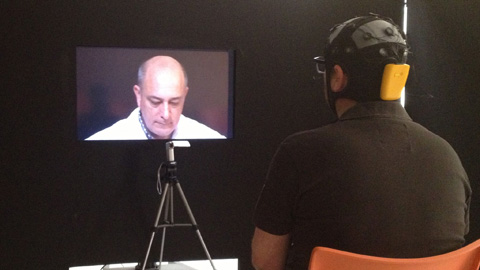Film edition affects spectators’ eye-blink rate

02/03/2017
Film edition affects spectators’ eye-blink rate. The editing style considered chaotic and with a lack of continuity, known as the MTV style and associated to video clips, inhibits the frequency with which spectators blink when compared to more conventional editing styles such as sequence shots and those used in classic Hollywood films. This is the conclusion reached by a recent publication in Scientific Reports of the Nature group.
Blinking is a sign of attention. It was previously associated with a narrative comprehension of contents. Previous research had demonstrated that blinking was affected by the contents of narratives, both in audiovisual situations and in direct oral communications. In this study, researchers demonstrate that the editing style also affects eye-blink rates. Therefore, the frequency with which we blink is affected by both the narratives we are faced with and the form of the audiovisual contents we consume.
The work carried out by researchers at the Faculty of Communication Studies of the Universitat Autònoma de Barcelona and at the Division of Neuroscience of the Pablo de Olavide University has also compared perceptual differences between audiovisual professionals, such as editors, and people from other fields. They discovered that audiovisual professionals, constantly taking decisions associated with narrative editing, to a large extent inhibit their rate of blinking when responding to audiovisual stimuli. That means that working professionally with audiovisual contents modifies visual behaviour.
These results can be of interest when applied to creating audiovisual contents aimed at increasing attention. This could range from entertainment, such as films and TV series, to advertising, and could also be useful for patients with attention deficit.
Moreover, a low blink rate is associated with blurred vision, visual fatigue and even with dry eye syndrome. For this reason, results could be of clinical interest for patients with visual problems caused by a low eye-blink rate. According to these results, audiovisual professionals should take special care of their eyes given that they strain them more due to their decreased rate of eye blinking.
The research was conducted with 40 individuals, 20 of them professionals from the audiovisual field, and with the use of electromyographic techniques. Participants were randomly presented with three different editing styles: sequence shot, Hollywood and MTV. The stimuli were created on an ad hoc basis for the research. Professionals from Radio Televisión Española participated in the study thanks to a collaboration with the Instituto RTVE. Celia Andreu-Sánchez and Miguel Ángel Martín-Pascual are members of the Neuro-Com research group and lecturers at the UAB's Faculty of Communication Studies. Agnès Gruart and José María Delgado-García are members of the Division of Neuroscience and professors at the Pablo de Olavide University in Seville.